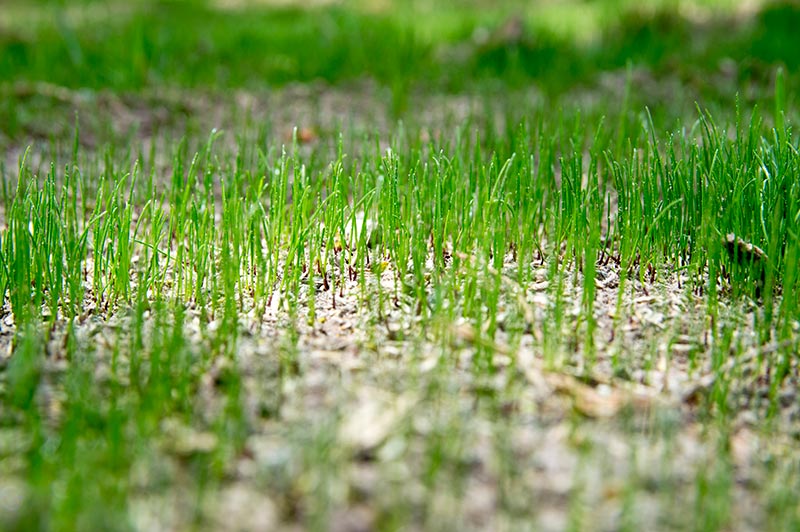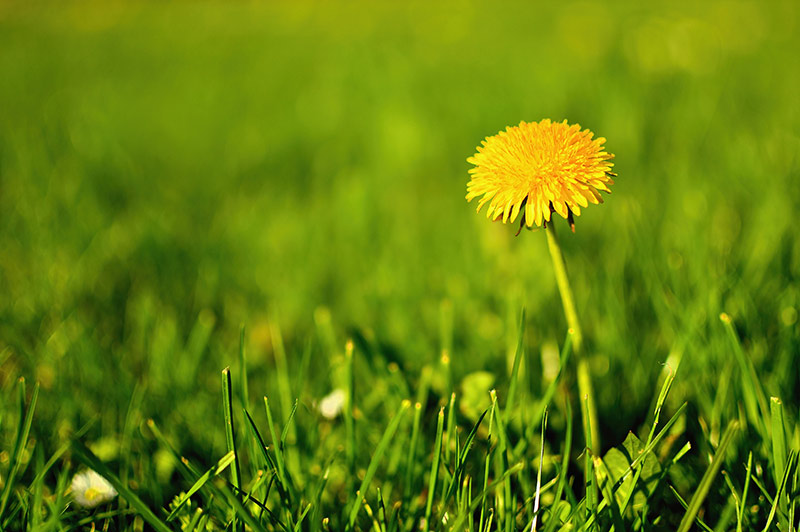When and How to Fertilize Your Lawn
In some ways, lawns are a lot like people. Operating at the peak of beauty and performance requires a good diet and proper care. Lush, thick, green lawns depend on properly timed, properly balanced nutrition to look and grow their best. Understanding when and how to fertilize your lawn can help you and your grass stand out from the rest.
- When and How to Fertilize New Grass
- When and How to Fertilize Established Lawns
- How to Apply Lawn Fertilizer for Best Results

Starter fertilizers help your new seed or sod get started right.
When and How to Fertilize New Grass
If you're starting a new lawn from seed, sod or plugs — or you're doing bare lawn spot repair — a starter fertilizer helps grass get the perfect start. Unlike established lawns, new grass benefits from extra phosphorus, an essential plant nutrient that supports strong, deep roots. Some states only allow phosphorus-containing lawn fertilizers on new grass, so check with your county extension office if you're unsure.
On fertilizer products, phosphorus is the middle number in the N-P-K ratio — usually "0" in normal lawn fertilizers. But with Pennington UltraGreen Starter Fertilizer 22-23-4, you get an ideal ratio of nitrogen, phosphorus and potassium, plus other essential lawn nutrients, including iron for deep green color. This premium fertilizer blend starts feeding new grass immediately and keeps feeding it for up to three months.
Always follow guidelines for the best time to plant grass seed for your region and grass type, then fertilize accordingly. For seed or plugs, apply fertilizer with a regular lawn spreader before you plant. If you're starting a lawn with sod, fertilize after your sod is in place.
With any new lawn area, avoid using crabgrass preventer fertilizers or weed & feed fertilizers within four weeks before planting time. After seeding, wait until your new grass gets established and you've mowed your lawn at least three times.

Weed & feed fertilizers kill tough weeds and feed your lawn.
When and How to Fertilize Established Lawns
To keep your existing lawn looking its best year-round, choose a fertilizer plan that meets its changing seasonal needs. At Pennington, we make it simple for northern and southern lawns. Just follow our four-part annual lawn fertilizer program:
Part 1 – Early Spring
Between February and April, temperatures warm and weed seeds start to germinate. Prevent new weeds — and feed your lawn in the process — with Pennington UltraGreen Crabgrass Preventer Plus Fertilizer III 30-0-4. You can stop new weeds before their roots get established and control new weeds for up to five months.
Timing is critical for this step. Make sure it's applied before crabgrass seed germinates — that happens when soil temperatures reach 55 degrees Fahrenheit. For best results, apply with a spreader to actively growing turf and give your lawn at least .5 inch of water from rainfall or irrigation within 14 days.
On top of weed control, Pennington UltraGreen Crabgrass Preventer Plus Fertilizer III 30-0-4 delivers iron and fast-acting nitrogen for immediate greening, and slow-release nitrogen for extended feeding for up to three months. Always follow the label instructions for your specific grass type. Do not apply this product within 60 days of overseeding. Wait until the following year before treating new sod.
Part 2 – Late Spring
Between April and June, existing weeds launch into active growth. Weed & feed fertilizers combine broadleaf weed killers with nutrients to feed your actively growing lawn:
- Pennington UltraGreen Weed & Feed 30-0-4 treats northern and southern grasses to kill more than 250 weeds from tip to root. It feeds your lawn essential nutrients for thick growth and rich color. Plus, it keeps feeding for up to three months.
- Pennington UltraGreen Southern Weed & Feed 34-0-4, designed especially for southern lawns, kills tough existing weeds* and keeps controlling new weeds for up to three months. And while it does that, this product keeps feeding your lawn the essential nutrients it needs.
Always check weed & feed labels for your specific grass type and follow instructions carefully. Weed & feeds are most effective when weeds are young and small. For best results, apply the product in the early morning when grass is wet with dew and no rain is forecast for one to two days.
If you plan to overseed, avoid weed & feed for four weeks before. After overseeding, wait until your third mowing occurs. For sodding, sprigging or plugging, wait four weeks before you weed & feed so new grass can start without delay.
Part 3 – Summer
Between June and August, proper feeding helps strengthen lawns against heat and drought. Keep your lawn beautiful and resilient with Pennington UltraGreen Lawn Fertilizer 30-0-4. This premium lawn fertilizer, ideal for northern or southern lawns, keeps feeding for up to three months. Your lawn gets essential nutrients, including iron for rich color, and you get thick, lush green grass.
Always check the label for your specific grass type, then follow instructions accordingly. Used as directed, you can apply Pennington UltraGreen Lawn Fertilizer 30-0-4 to wet or dry lawns and not worry about fertilizer burn.
Part 4 – Late Summer to Late Fall
Between August and November, grass slows down and prepares for the winter months. At the same time, broadleaf weeds start active growth again. With Pennington UltraGreen Winterizer Plus Weed & Feed Fertilizer 22-0-14, you can feed your northern or southern lawn nutrients essential to its winter prep and spring green-up — and kill broadleaf weeds. As a general rule, allow six to eight weeks between fertilizing and your first expected frost.
As with all fertilizer products, check the label and follow instructions for your specific grass type. If you're overseeding, wait until next year for weed & feed. Instead, turn to Pennington UltraGreen Lawn Fertilizer 30-0-4 for the year's final feeding.

Always sweep excess fertilizer off sidewalks and patios to avoid runoff.
How to Apply Lawn Fertilizer for Best Results
Whenever you apply fertilizer, always follow best practices for fertilizer safety. For best results, mow your lawn one to two days beforehand. Then set your spreader to the setting recommended on the product label.
- For drop spreaders, start with two strips across your lawn's ends. Then work back and forth, overlapping each swath slightly.
- For broadcast spreaders, start on the outside and work in, overlapping slightly as you go.
Always shut the hopper when you stop and turn to prevent a fertilizer pile. When finished, sweep excess fertilizer off hard surfaces, such as sidewalks and driveways, to avoid iron stains and fertilizer runoff.
By following these lawn fertilizer tips, you can keep your grass at the peak of performance, beauty and health. At Pennington, we take pride in providing you with the best in lawn fertilizers and expert advice to help you have a lawn you're proud to own. Stay connected with our email newsletter for accurate, timely tips and offers to help you make the most of your lawn and home.
*dollarweed, clover, henbit and chickweed
Always read product labels thoroughly and follow instructions, including specific guidance for your grass type.
Pennington is a registered trademark of Pennington Seed, Inc.
UltraGreen is a registered trademark of Central Garden & Pet Company.




